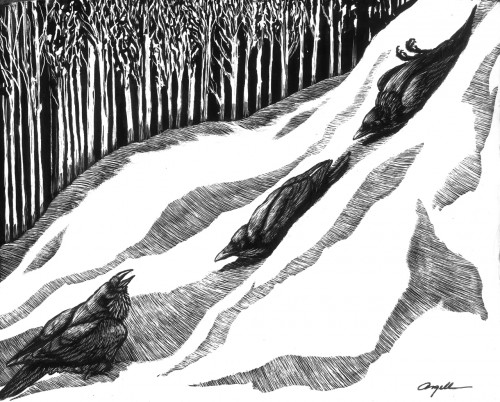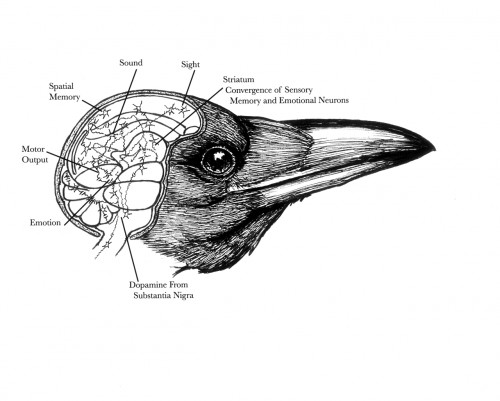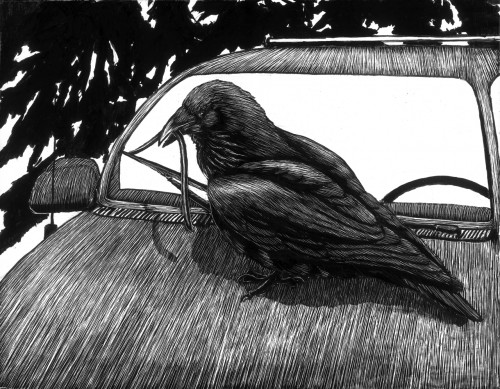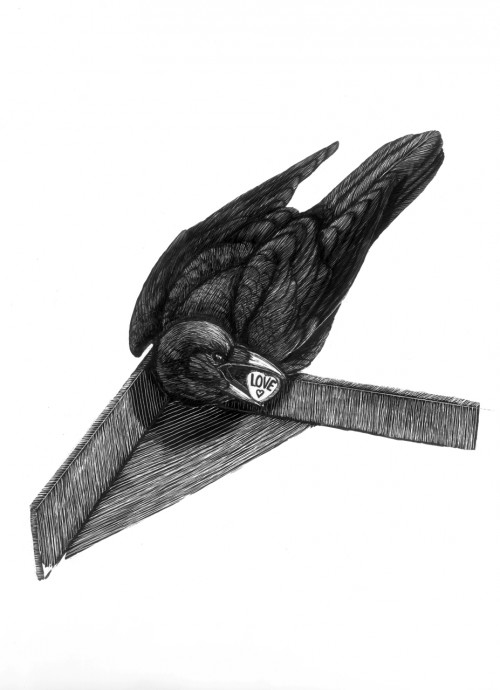Gifts of the Crow: A Conversation with John Marzluff and Tony Angell

As part of our “Nature of Writing” series, John Marzluff & Tony Angell present Gifts of the Crow: How Perception, Emotion and Thought Allow Smart Birds to Behave Like Humans June 18 at 7pm in the Readings Gallery at Village Books in Bellingham; Free!
Q: How did you initially become interested in studying crows and other members of he corvid family?
John: For me it was luck. My plan in graduate school was to study the feeding behavior of white-breasted nuthatches. When I first presented this research idea to my major professor, Russ Balda, he listened, but was quick to suggest that I forget about nuthatches and join his long-standing study of the pinyon jay. Russ always liked to have at least one student on the jay project, and currently he had none. As he told me about the jays and what was already known about them, I was hooked. Through his past efforts and those of his former students, the flock I would study was nearly entirely banded, allowing me to follow individual birds and relate their past experience and lineage to their current behavior. A detailed, yet mysterious world was open. So, I spent 7 years tracking jays, finding their nests, watching them rear their young, testing their communication skills, catching and banding them. I learned how to think like a corvid, to interpret their actions, and to see their world. Once you get to that point with another blood, you can’t go back. And I never have. I enjoy studying other types of birds and even other animals, but none engage me like the corvids.
Tony: My contact with corvids first came as a kid of ten years or so who also had kestrels, western screech owls and loggerhead shrikes that my mother tolerated as part of my live-in zoo. Scrub jays were abundant in the San Fernando Valley of my youth and they were quick to assemble whenever I would fly my small falcons. It got me to wondering about these inquisitive birds that were quick to mob my feathered menagerie. I soon was feeding young jays and it wasn’t long before I discovered their relatives, the common raven that nested in the nearby Santa Monica Mountains. We forged a kinship and I was soon drawing and painting these species as well as taking mental notes on their behavior that set them apart from other birds. I was hooked and soon I was keeping company with yellow-billed magpies and Steller’s jays, as well. While I would pursue an academic career different from science, once I finished grad school I found myself living with a raven and this eloquent bird set my course to study these species and interpret them artistically throughout my life.
Q: How did you come to write Gifts of the Crow?
John: It seems everyone has a crow story. So, whenever I talk about our research and ideas I am told something new about crows. The volume of stories was so compelling and opened up such a rich and varied life that we were compelled to synthesize and interpret what so many had told us. We did not just want to catalog the crows that others knew; we wanted to use these insights to better compare the world of the crow with our own world. The recent flurry of discoveries concerning how the bird brain works allowed us to use neurobiology to interpret what we were told. Grasping the complex field of neurobiology was a challenge for us, but it certainly gave us a solid foundation upon which to better understand and contextualize what we learned crows were capable of.
Tony: As John says, after finishing our last book, In the Company of Crows and Ravens, we were inundated with new information related to corvid behavior. It seemed reasonable that we would want to share this and arguing earlier about the coevolution humans shared with corvids, we looked to the possibility of organizing this information from laboratory and field around the common traits/characteristics we have in common with these species. As an author who is particularly fond of interpreting the corvid form in illustration, I found that the book became another opportunity to convey or elaborate information in a manner that the narrative might miss. To me it is the marriage of art and science.
Q: In the book. you explain that crows have taken on seven key human characteristics: language, delinquency, insight, frolic, passion and wrath, risk-taking, and awareness. What role did we, as humans, play in the development of these characteristics?
John: Actually, it may be more appropriate to consider these characteristics as part of our shared, albeit ancient, heritage. Because mammals, including humans, and birds both evolved from a common reptile ancestor, our brains and the chemicals that control our behaviors have some important similarities. This neural base and the way electricity and chemistry conspire to spark and mold our actions also occur in crows (and all birds, mammals, reptiles, and other vertebrates). Crows, and other birds for that matter, then have the ability to develop the same characteristics that we have. We argue that crows have done so in large part because their modern representatives have evolved in our company. By living among us they indeed learn phrases of our language and use our waste for their playful amusement. Their risk-taking, ability to make causal connections, and use of insight to solve problems is demanded by our unpredictability. Less nimble animals would not be able to capitalize on our creative and avoid our destructive hand the ways crows can. Crows use our trash for food and toys. Our cars become their tools. Our caring disposition is co-opted to provide them daily, specially prepared meals. To fully exploit us, as crows have done, requires a quick brain that associates risk with reward, adjusts to failure, and tempers first responses with emotion. To do less would doom the crow, like so many other species we have lived with, to obscurity or even extinction.
The advantage that a crow gains from its marvelous brain also give it time to play and get into trouble. And these actions are most likely to occur in relaxed settings. This is exactly what our towns and cities provide for crows. Here, we reduce many natural threats, like predators, and provide abundant food and shelter. The safe havens we provide may allow the crow mind to innovate, test, and consider. Certainly such an environment fosters play. Stressed animals don’t play. It enables delinquency. A successful crow has spare time and in many cases this is when their delinquent side shines. They harass our pets, take our prized possessions, and seem ever to be planning their next way under our skin.
Our domination of Earth challenges virtually every species. We change climate, move mountains, disrupt long-standing nutrient cycles, and extinguish species outright. Species that are able to coexist with us are shaped by our actions. For some animals, like a small bird called the dark-eyed junco, this results in changed plumage. But for others, those that live long lives in social groups and that have large brains like crows, our influence changes their shared traditions, or culture. This is not just a one-sided relationship, however. As our ancestors watched animals, we suspect they were influenced by what they saw. Our legends and beliefs were kindled by animal action. Take the antics of crows that are known to steal tallow candles from Japanese shrines. This sort of behavior may be a root cause of Northwest Native American legends that propose ravens stole the light from an early chief and used it to illuminate the world.
Tony: John sums up our book. As humans, we are in a unique position to test and measure these shared characteristics and in doing so we begin to give credit to other species where credit is due.
Q: During your research, which discoveries about crows did you find to be the most surprising?
John: Six years after catching a few crows, I walked out of my office building and was immediately recognized by these birds (and many other crows I never touched). I was floored! Fortunately, I wore a special mask when I captured birds and it is only when I wear this mask that they recognize, scold, dive at, and mob me. Otherwise life on campus would be harried. Their amazing and lasting memory surprises me. Another real surprise is how often I see crows doing something I have never before seen! I’ve watched these birds for 3 decades, and yet just two days ago as I waited for my bus I saw one pick up a feather and give it to its mate! Beak to beak, the birds exchanged a gift, not 10 feet from me and other onlookers! The gift from male to female accompanied displays typically associated with mating and reinforced in my mind the possibility that these animals indeed know the value of a present.
Tony: When a raven was given to me many years ago, it soon became my most important emissary from the larger world of nature. It seemed that each day the bird, whose name was Macaw, held some surprise for me from its exceptional skills of flight and employment of its beak to powerfully exploit food sources or tenderly use to “preen” the hair on my neck as part of his social bonding process with me. And of course there are those very memorable moments from those mornings when he would greet me with the clearly spoken words, “Hello, Macaw,” something the bird had initially learned from my opening remarks each day and what he was now using to greet me independently. Macaw expanded my appreciation of the vast possibilities of emotions we share with other creatures, particularly corvids.

Q: Gifts of the Crow is filled with astonishing, and often hilarious and poignant, true stories of crows doing amazing things and displaying humanlike behavior. Which of these stories is your favorite and why?
John: I absolutely love the story from Sweden about magpies. It provides a nice anecdote to the experiments I have done to demonstrate the ability of corvids to recognize individual people. These small corvids clearly recognized Abbe and Inda Drakborg. As Inda fed the birds one winter, the magpies became increasingly bold, eventually ringing the doorbell to solicit their feed whenever they glimpsed Inda. This astounded Inda and made her happy, but her husband, Abbe, was not so impressed. He threatened the birds and they retaliated by white-washing his car every morning. He tried parking his car away from the house, but the magpies always found it and they discriminated between his car and Inda’s. These birds can not only discriminate among people, but also hold a grudge and seek revenge! I tell this story often as a warning to those who might dis the crow.
Tony: Yes the episode of the magpies taking “revenge” is a dandy, and while finishing our book we learned of crows, disturbed from their roosting inclinations by the use of sirens, also white-washing the vehicles of the local sheriff that had been responsible for the high pitched clamor. My other favorite true story involves the Montana crow that had learned to say, “Here doggie, here doggie,” and would cause confusion on the U of Montana campus by calling up the local mutts.
Q: What is your response to critics or other scientist who say that your interpretation of these stories as showing that crows have emotions and a high degree of intelligence are overly emotional responses on your part or too great a leap?
John: As a critical scientist I always try to temper my interpretation of animals’ apparently amazing behaviors. So, I sympathize with my colleagues’ criticism, but really do not agree that we have taken great leaps of faith in our book. We do not present single anecdotes of bizarre behaviors and interpret these. Rather, we look for corroborating observations. Consider, for example, a report that a person was given a gift from a crow. We saw the gifts, but not the giving, so we did not simply conclude that crows give gifts. Instead, we collected 5 or 10 other instances where people got gifts from crows and looked for commonalities and differences to sort among plausible hypotheses. In so doing we conclude gifts were exchanged and that they may or may not have been exchanged on purpose by the birds. We suggest it is entirely possible that crows tried to woo our friends with gifts. By entertaining this suggestion we have not taken observation too far, but yet we also have not discarded or denied interesting and extremely cognitive possibilities. In other cases, we look for parallels between what crows do and what is understood to be done in well-studied or conversant animals. If both animals are doing the same thing and they have the same mental machinery that is important to the task, we do often conclude that the crow is behaving in the same way as the better-known animal. For example, when we see a crow soaring in the wind for no apparent reason and with no apparent care, we suggest it is playing. We back up our assertion by showing that other animals, including humans, play under the same circumstances and that crows and these animals share the same neurochemicals that are known to regulate play in people. We wish we could just ask the soaring crow, “Are you playing?” But we cannot, so we do not want to ignore an interesting possibility. We do also look for reasons why it is not possible. Failing to find any reasons to the contrary, we are glad to stoke the creative energy of our colleagues and readers by suggesting, by gum, those birds are playing — and they might even dream about their adventure!
Tony: I think that a fragment of the biblical mandate, “multiply and subdue the earth and have dominion over it,” has corrupted our relationship with Nature and prevented from finding our place in Nature. As we discuss in our book, a respected scientist of the 19th Century erroneously concluded that the configuration of a bird’s brain was so unlike a mammal’s that the bird could only be a creature of instinct. Yet this erroneous conclusion endured for more than a century and as a result we have employed the term “bird brain” as a derogatory description of birds and humans who are devoid of cognitive capability. In spite of the vast body of evidence to the contrary, many people, including scientists, persist in the belief that we share little or nothing cerebrally with other creatures. It’s regrettable.
Q: Which of your experiments with crows reveals the most about crows?
John: I am partial to our new experiments that involve imaging of the crow’s brain as it faces a unique test; for example discriminating between the sight of a caring and threatening person. These images allow me to actually see how the bird brain perceives and considers information. We see directly that this is not a simple assessment that produces an innate response. Rather, it is a reasoned response that includes an emotional and memory component. In fact, it calls upon the same regions in the brain that we employ to make similar responses. It makes sense that crows temper their behavior, but without actually peeking under the hood, so to speak, we would never be entirely sure.
Tony: I continue to find the experiments with the New Caledonian crows to be remarkably revealing. One really wonders what cycling of information goes on in the bird’s brain as it faces a task that requires it to first retrieve a tool that will allow it to retrieve another very special tool that will allow the bird to gain access to a source of food that would otherwise be out of reach.

Q: How did you decide what subjects in the book to illustrate?
John: Learning neurobiology is in large part like learning a new language. Adding image to this terminology really helped me understand the crow’s brain and how it works. Tony’s more technical illustrations of the crow’s brain allow the reader to visualize anatomy, appreciate complexity, and grasp the ways in which the parts of the brain collaborate to influence behavior.
Tony: I have always sought to say in a drawing something that might be otherwise remain unsaid or unclear in the narrative. When John and I mapped out the brain of the crow to discuss different points, we felt we were really discovering something. In particular I remember holding up the empty skull of a crow to the light and seeing the inside of it. What an extraordinary structure of shelves and extensions and cleavages. Most brain studies show the parts of the brain laid outside of the skull, so to speak. By presenting the brain in situ and with our knowledge of the true shape of the inside of the bird’s skull, I think we gave our readers a much more realistic view.
We were also both inclined to show the range of behavioral animation, beauty, and variations of form in this family of birds and the drawings provided a chance to do this.
Q: What made you choose the title, Gifts of the Crow, and why do you think it fits?
John: When Gary Clark emailed me to say that a crow whom he regularly fed had given him a candy Conversation Heart that read “love,” I knew we were on to something unique. And the more we dug, the more unique information we uncovered about the many ways that crows give gifts to people. The theme of gifting seemed broad enough to cover the many, varied aspects of crow behavior that we cover in the book—literal gifts, mental gifts, and gifts of inspiration and knowledge.
Tony: My friend the raven Macaw “gifted” me a richer understanding of Nature in general and animal behavior in particular. While interpreting many wild subjects in line, stone, and bronze, no other subjects have given me more artistic inspiration than the corvids.
Literal gifts are certainly one of the exchanges we share with the crow family, but they have given us fuel for our myths, song, literature, music, dance, painting, and sculpture over tens of thousands of years – gifts beyond measure. Now science is just beginning to discover other gifts that they have to offer to us.
Q: What do you hope readers will take away from reading Gifts of the Crow?
John: I hope readers gain a deeper understanding of bird behavior, a special appreciation for the brain of a bird and how it functions, and most importantly greater respect for the many other sentient beings we share our planet with. If only one thing is gained, I hope it is that to call someone a “birdbrain” is a compliment, not an insult.
Tony: Sometimes we hear people say, there are only two ways of looking at a crow, “you either love them or hate them.” From our book I would hope that these two attitudinal poles might be replaced with a more middle ground of admiration for these special birds. Also, I would hope that the readers, while seeing these species as a revealing subject for scientific discovery, would also consider them to be exceptional sources of subtle beauty and provocative emotional possibilities. Should one apply his or her artistic mind to the corvids, the aesthetic gifts will be great.

